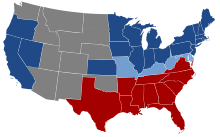The Northern United States, commonly referred to as the American North, the Northern States, or simply the North, is a geographical and historical region of the United States.
Before the 19th century westward expansion, the "Northern United States" corresponded to the present day New England region. By the 1830s it corresponded to the present day Northeast and Great Lakes region.
Before 1865, the North was distinguished from the South on the issue of slavery. In Southern states, slavery was legal until the ratification of the 13th Amendment in 1865. Northern states had all passed some form of legislation to abolish slavery by 1804. However, abolition did not mean freedom for some existing slaves. Due to gradual abolition laws, slaves would still appear in some Northern states as far as the 1840 United States Census.[4] New Jersey was the last Northern state to end slavery. Due to their states gradual abolition laws, slavery came to an end in New Jersey when the 13th Amendment was ratified in 1865.[5]

Durante la Guerra Civil Estadounidense (1861-1865), los estados del Norte comprendían los estados de EE. UU. que apoyaban a los Estados Unidos de América, conocidos como la Unión . En este contexto, "el Norte" es sinónimo de Unión, mientras que "el Sur" se refiere a los estados que se separaron de EE.UU. para formar los Estados Confederados de América .
Sin embargo, existe cierto desacuerdo histórico sobre exactamente qué estados componían el Norte en el contexto de la Guerra Civil, ya que cinco estados esclavistas permanecieron en gran medida en la Unión: los estados fronterizos del sur de Missouri , Kentucky , Virginia Occidental , Maryland y Delaware , junto con el territorio indio en disputa , aunque Missouri y Kentucky tenían gobiernos confederados y unionistas duales en competencia con el gobierno confederado de Kentucky y el gobierno confederado de Missouri , la Confederación controlaba más de la mitad de Kentucky y la parte sur de Missouri a principios del siglo XIX. guerra. La Confederación perdió en gran medida el control en ambos estados después de 1862; Dependiendo de la fuente, algunos de estos estados y territorios pueden incluirse en cualquiera de las regiones. [6]
Geográficamente, el término incluye los estados y regiones de los Estados Unidos de América que se encuentran en la parte más septentrional del país. Incluye estados a lo largo de la frontera entre Canadá y Estados Unidos .
La Oficina del Censo de Estados Unidos divide algunos de los Estados Unidos más septentrionales en la Región Medio Oeste y la Región Noreste . [7] La Oficina del Censo de EE.UU. también incluye los estados más septentrionales del Noroeste , que se encuentran dentro de la Región Oeste . [7]
Entre las ciudades más grandes por población en el norte de Estados Unidos se encuentran: Nueva York , Chicago , Filadelfia , Boston , Pittsburgh , Columbus , Indianápolis , Cleveland , Cincinnati , Minneapolis , St. Paul , Buffalo , Milwaukee , Detroit y Des Moines .
The Northern United States also comprises most of the Northeast megalopolis, which is the most populated and urbanized megalopolis in the United States. The Great Lakes megalopolis is also located in the Northern United States, largely in the Great Lakes region and Midwest.
The Northern United States has a humid continental climate. Most of the Northern states have warm to hot summers and significant snowfall during the winter.